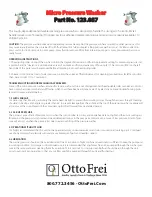
22
Operative Instructions
1
Fig. 14.2
In case of program interruption, proceed with a new
treatment of the load.
6.2.2 Preparing the load
a
WARNING! The maximum weight that the
open door can withstand is 66 lbs (30 kg).
The maximum volume of the wash chamber
is 44 US gal (165 l).
- The glassware to be washed must be placed on the
relative racks, making sure that they do not overlap
one another.
Ö
IMPORTANT NOTE! The cleaning quality
depends on the correct loading of the
glassware.
- Empty any residual liquids from the instruments and
containers before inserting them in the chamber,
washing all residues well (e.g. disinfectant solutions)
in cold water.
- Remove non-water soluble residues such as paint,
adhesives and polymer compounds using appropriate
solvents.
- Scoop nutrient media (Agar) out of petri dishes.
- Shake out any blood residues and remove any clots.
- If necessary rinse the wash load briefly with water to
avoid introducing coarse soiling into the machine.
- Remove all stoppers, corks, labels, sealing wax
residue, etc
- Glassware wetted with solutions containing chloride
or hydrochloric acid should first be rinsed in cold
water and then placed in the drawers for washing.
After use, they should be placed on a settling tank for
the time necessary to bring them to the rinse area.
b
HAZARD! The amount of residual solvents
and acids on items going into the chamber
should be minimal. There should be no more
than a trace of any solvents with a flash point
of below 70°F (21°C). Chloride solutions, in
particular hydrochloric acid, are corrosive for
iron materials.
- Make sure that the glassware do not fall off the racks
and inserts and do not hang from the grid bars.
- Check that injector nozzles and connectors are
securely held in position in the baskets or inserts.
- Insert the glassware into the appropriate nozzles.
- Position container-shaped objects so that liquids can
flow easily and, if possible, place tall and heavy tools
in the centre of the rack.
- Place pointed or sharp objects in such a way as to
prevent anyone from being injured by them.
- Do not treat broken glass instruments with the
glasswasher.
a
WARNING! Broken glass can result in serious
injury when loading or unloading
- Components with special geometries must be
arranged so as to allow the water to flow out.
- Introduce only suitable steel instruments, resistant to
corrosion.
- Objects made completely or partially of plastic must
be resistant to high temperatures.
- Nickel-plated and chrome-plated and/or aluminium
instruments and tools may not always be suitable
for machine treatment. They require special process
conditions.
- If possible, disassemble the modular instruments
following the manufacturer’s instructions and treat
the individual parts separately.
- Treat small glassware and parts in special inserts.
- Before the automatic treatment, check that the
lumen and hollow body glassware can be treated
internally and remove any obstructions.
- Carefully place the load in the supports.
- Objects must not be put inside each other nor cover
each other. Do not place objects so close to each
other that they cannot be washed properly.
- Arrange the load so that all surfaces can be reached
by the washing liquid. Otherwise they will not be
cleaned!
- Place the objects so that the liquids can flow out
without hindrance.
- Tall, narrow, hollow and heavy items should be placed
in the centre of the rack. This will ensure better water
Содержание TIVA8-L
Страница 55: ...55 Operative Instructions...
















































